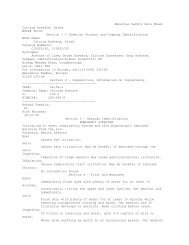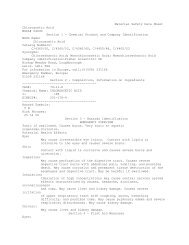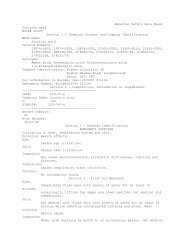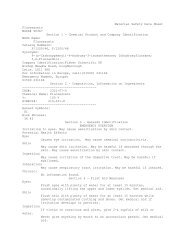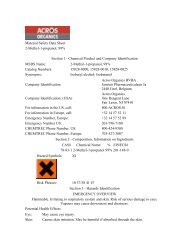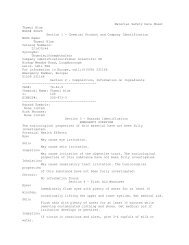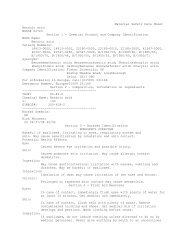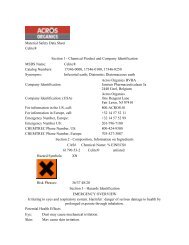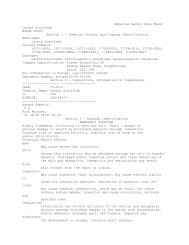Oxalic acid - Clayton State University
Oxalic acid - Clayton State University
Oxalic acid - Clayton State University
You also want an ePaper? Increase the reach of your titles
YUMPU automatically turns print PDFs into web optimized ePapers that Google loves.
occur following ingestion of oxalic <strong>acid</strong> or its soluble salts.<strong>Oxalic</strong> <strong>acid</strong> can bind calcium to form calcium oxalate which isinsoluble at physiological pH. Calcium oxalate thus formed mightprecipitate in the kidney tubules and the brain. Hypocalcemiasecondary to calcium oxalate formation might disturb the functionofthe heart and nerves.Inhalation:Causes chemical burns to the respiratory tract. Inhalation ofoxalic<strong>acid</strong> dust or vapor produces irritation of the respiratory tract,protein in the urine, nosebleed, ulceration of the mucousmembranes,headache, nervousness, cough, vomiting, emaciation, back pain (duetokidney injury), and weakness.Chronic:Inhalation of oxalic <strong>acid</strong> dust or mist over a long period of timemight result in weight loss and respiratory tract inflammation.Ratsadministered oxalic <strong>acid</strong> at 2.5 and 5% in the diet for 70 daysdeveloped depressed thyroid function and weight loss. A study ofrailroad car cleaners in Norway who were heavily exposed to oxalic<strong>acid</strong> solutions and vapors revealed a 53% prevalence of urolithiasis(the formation of urinary stones), compared to a rate of 12% amongunexposed workers from the same company.Section 4 - First Aid MeasuresEyes:In case of contact, immediately flush eyes with plenty of water forat least 15 minutes. Get medical aid immediately.Skin:In case of contact, immediately flush skin with plenty of water forat least 15 minutes while removing contaminated clothing and shoes.Get medical aid immediately. Wash clothing before reuse.Ingestion:If swallowed, do NOT induce vomiting. Get medical aid immediately.If victim is fully conscious, give a cupful of water. Never giveanything by mouth to an unconscious person.Inhalation:If inhaled, remove to fresh air. If not breathing, give artificialrespiration. If breathing is difficult, give oxygen. Get medicalaid.Notes to Physician:Treat symptomatically and supportively.Antidote:Intravenous administration of calcium gluconate or calcium chloridemay be required if hypocalcemia or hypocalcemic tetany occur.Section 5 - Fire Fighting MeasuresGeneral Information:As in any fire, wear a self-contained breathing apparatus inpressure-demand, MSHA/NIOSH (approved or equivalent), and fullprotective gear. During a fire, irritating and highly toxic gasesmay be generated by thermal decomposition or combustion. Use waterspray to keep fire-exposed containers cool.Extinguishing Media:Use water spray, dry chemical, carbon dioxide, or alcohol-resistantfoam.







